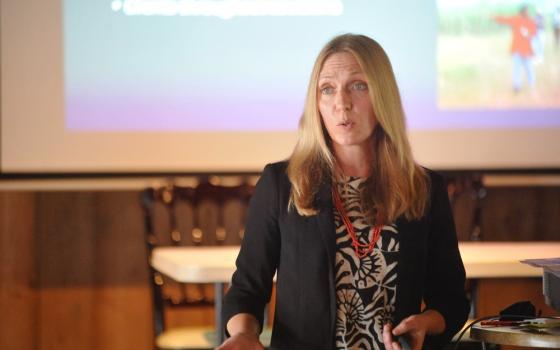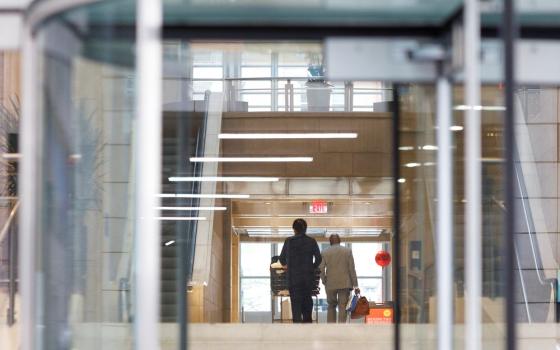
SAN SALVADOR, EL SALVADOR -- Madre Luz Isabel Cuevas was one of the sisters who shared a small circle of life with Archbishop Oscar Romero at a cancer hospital that he chose as his residence here. At age 85, she remains today the last living witness to Romero’s assassination, and though she’s never been asked formally to give her accounting of that day, it remains vibrant in her memory.
Romero’s simple hospital quarters, chosen over a much grander residence he was offered in an exclusive gated enclave, served as a respite from the growing chaos in El Salvador until March 24, 1980, when he was struck down by a single bullet as he said Mass in the hospital chapel. As the last surviving witness to his murder, Cuevas’ testimony is significant, though it was not recorded as part of the official church’s process to formally recognize Romero as one of Latin America’s greatest saints.
When the Carmelite Sisters of St. Teresa in San Salvador opened a 120-bed hospice for indigent cancer patients in 1966, they could not have known that its most famous resident was to be an archbishop.
The story of Hospital Divina Providencia, also called el hospitalito (little hospital), is well-known now in Salvadoran circles, but in 1977 it was just another background detail that revealed the quiet simplicity of Romero, who had just been appointed archbishop of San Salvador and asked the sisters if he could live there as their chaplain.
 Romero, a favorite among San Salvador’s wealthy elite for his conservative stance on church involvement in political and social issues, was first offered a spacious home and an expensive car in one of the city’s most exclusive sections. Romero’s decision to live with the sisters instead, first in a small room across from the sacristy in the hospital’s chapel, and later in a modest three-room structure they built for him nearby, was an early indicator of how independent he knew he needed to be in order to fulfill his role as pastor for all the people, rich and poor.
Romero, a favorite among San Salvador’s wealthy elite for his conservative stance on church involvement in political and social issues, was first offered a spacious home and an expensive car in one of the city’s most exclusive sections. Romero’s decision to live with the sisters instead, first in a small room across from the sacristy in the hospital’s chapel, and later in a modest three-room structure they built for him nearby, was an early indicator of how independent he knew he needed to be in order to fulfill his role as pastor for all the people, rich and poor.
Life with eight Carmelite sisters who staffed the hospital during the three remaining years of his life gave Romero a kind of personal still point that enabled him to withstand the growing centrifugal pull of his multiple roles as pastor, advocate, peace broker and shock absorber for a church and a nation being swept by social unrest and violent repression toward civil war.
Over breakfast and other shared meals, through his preaching at daily Mass and weekly holy hours, the sisters came to know Romero, his outer reserve hiding a gentle humor. Though he tried to spare them the stress he brought home from long days at his seminary and cathedral offices, they read it in his silence as tensions with the government and even with his fellow bishops grew and death threats mounted. The simple residence became his retreat, his spiritual cell, his refuge from chaos in the streets, standoffs between protesters and the army that often ended in killings and disappearances. Increasingly, Romero’s tiny compound also served as neutral ground where students, outlawed labor leaders, politicians, rebels and army officers could come to seek his counsel.
Cuevas, seated in a wheelchair during a March 20 interview with NCR at her motherhouse in San Salvador, said that though she has never been asked for her testimony as part of the canonization process, she remembers that evening as though it were a movie playing in her memory.
“When the shot rang out, some people dove under the pews, but my first reaction was not one of fear but of anger,” she said. As other sisters and laypeople in the chapel went to the fallen Romero, Cuevas said her instinct was to pursue the killer. “I turned in the direction of the gunshot, thinking I might capture him with my glance. Monseñor Romero was down on the floor behind the altar, blood pouring from his nose and ears. Nothing could be done to save him.”
Because the Mass was being said in memory of the mother of a local publisher, a photographer was present, and he recorded the entire death scene in shocking detail.
As Cuevas described Romero’s final moments, she was eager to correct some dramatic inaccuracies that have become part of the story over the past 30 years. Romero was not killed while raising the cup of consecrated wine, as depicted in the 1989 film “Romero,” but right after the homily and as he prepared the gifts of bread and wine at the offertory.
“The killer waited until Monseñor was looking down at the altar as he spread the corporal. The bullet struck him in the chest. He tried to steady himself by grabbing the altar, and he pulled at the altar cloth. The cup with the wine remained standing but the ciborium with the hosts was tipped over and the hosts were scattered. He fell back toward the arms of the Jesus on the crucifix,” she said.
Such details were important to the sisters as they later interpreted the meaning of Romero’s death. For them, it was clear that the way he died revealed God’s plan for the slain archbishop.
“We saw it as God saying, ‘Today, Oscar, I am not asking you to offer the bread and wine. Today the victim will be you.’ ”
After Romero’s murder, civil war broke out in 1981. Over 75,000 additional victims would be added to his death until a peace accord was brokered in 1992. During the war, the little hospital continued to care for cancer patients, but its ministry and the lives of the sisters were forever changed to include guardianship of the memory of Romero. It is a role Cuevas takes very seriously.
[Pat Marrin was in El Salvador in March to cover the 30th anniversary of the death of Archbishop Oscar Romero. He edits Celebration, NCR’s sister publication. His e-mail address is patmarrin@aol.com.]



